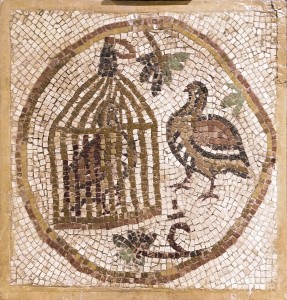All our thinking depends on metaphors. The work of George Lakoff and Mark Johnson explains the way in which we build our cognitive models on a particular metaphor, which is mapped onto a physical experience schematised into our neural connections. For example, the picture here illustrates an old Platonic cognitive model for the mind or soul in relation to the body: the body as a cage in which the otherwise free mind is constrained. It never seemed to occur to anyone using this metaphor that our experience of being imprisoned is a physical one, and we’d need a body to even experience what it meant to be released from a cage. Nevertheless, a good deal of Plato’s philosophy depends on this metaphor.
Plato’s basic mistake here is one that we are all prone to: of adopting just one basic metaphor and assuming that it is the final word. A ‘stuck’ metaphor is what one might otherwise refer to as a metaphysical belief. As long as we take them provisionally, however, metaphors are also the only way in which we can build up an understanding of anything. Very often, if you’re trying to explain something abstract, people only ‘get it’ when you use a metaphor. That means they’ve found a way of making it meaningful in relation to their wider bodily experience. Metaphors tend to come in connected groups, too (Plato didn’t just use the one about the soul in a cage, but also the soul as a charioteer, and many others). We can reinforce one metaphor with others, or challenge one metaphor with a different one. Perhaps the major difference between creative philosophy and mere analysis is that creative philosophy works with metaphors, pulling them together, testing out compatibility and incompatibility, whilst mere analysis just works away doggedly within one cognitive model on the assumption that it is right.
One crucial point in Middle Way Philosophy is that a belief is not ‘merely relative’ because it’s dependent on a metaphor, any more than it’s absolutely true because it’s hit the right metaphor. Some metaphors provide more adequate models for interpreting conditions than others do. The better ones can link together a great many other metaphors, as well as explaining a wide range of experiences. We can stretch metaphors to make them bigger by linking them with others, and the more provisionally we are holding the metaphor, the easier it is to do this.
So, here is a challenge to Middle Way Philosophy that I’ve been reflecting on. There is one key metaphor of the Middle Way, which relates to our experiences of following a path and of balancing: but is this metaphor being relied on too much? How can this metaphor be provisional when it is also so all-encompassing?
I have two linked responses to these linked questions. One is that Middle Way Philosophy doesn’t just depend on the metaphor of the Middle Way, but also that of integration. Another is that the bigger and stretchier a metaphor is, the more provisional it is. Middle Way Philosophy is not an ultimate explanation, but at the same time it is the kind of explanation that becomes more adequate the more it encompasses.
Firstly, then, the metaphor of the Middle Way and that of integration. These two models offer rather different models of thinking, but they are still linked. Integration is basically the Middle Way inside out. Whilst the Middle Way is a negative model that takes our motivation for granted and just tells us that there are metaphysical traps to avoid on either side, integration takes the things on each side more positively, suggests that they do themselves have motivating power, and that both the energy and the metaphors on either side can be positively incorporated into a whole The two metaphors complement each other enormously and yet remain compatible. Without the rigour of the Middle Way, integration models can get rather naïve and new-agey; but without integration, the Middle Way can get rather dry and negative.
Would it be possible to combine the two metaphors? Well, here’s an attempt. Suppose you’re captain of a ship heading through a dangerous strait between two rocks. Some of your passengers want to go straight on, but others want to pick up friends from the rocks on either side. So, you do head straight on, but not before you have picked up further passengers and rescued them from the rocks on either side. This requires both courage and skill. Once you’ve picked up all the passengers from both sides, everyone can be united in urging you onwards through the rest of the strait.
This combination of metaphors illustrates the way that even metaphors that at first seem separate can be combined and stretched. That’s one reason why I’m interested in studying even religions that seem to have a heavy metaphysical emphasis, like Islam, and, metaphorically speaking, picking up the passengers from that rock too. I want to argue that the more a given metaphor can explain the strengths of others in that way, without getting sucked into the assumption that any one metaphor is final, the more justified confidence we can have in that metaphor. If a given approach can offer responses that account for the successes other metaphorical approaches, rather than simply rejecting them as wholly wrong, it provides the basis of a bigger and more adequate metaphor.
I think Middle Way Philosophy is like this. That’s one of the reasons why it is so all-encompassing: it needs to be able to account for the insights available from different traditions and from different specialisms. However broad it is, though, to remain provisional it must be fallible. If someone else can come up with a better theory that explains all the things Middle Way Philosophy explains and does all the things it does: explaining the nature of objectivity, providing a justifiable ethics, resolving the absolutism/ relativism split, combining theory with practice, facts with values, the religious and the secular, art and science, whilst taking into account the scientific evidence for things like embodied meaning, the splits in the brain and our cognitive biases, then I will drop this theory and come and help them on theirs. Theories based on particular metaphors can be superseded – but they have to be superseded in doing the job that they set out to do, explaining both the successes and failures of the theory to be superseded.
This blog was originally posted on my ‘Middle Way Philosophy’ site in Sept 2013
Picture: Byzantine metaphor for the soul by Ken & Nyetta CCSA


